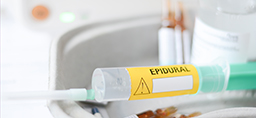
Of all the reasons to visit a hospital, childbirth may be the absolute best.
The goal is to have mom and baby return home as soon as possible, happy and healthy.
Unfortunately, even in the 21st century, this isn’t always the case. Risk is inherent in the birth process.
Would you be surprised to learn that maternal mortality rates in the U.S. are headed in the wrong direction? It’s true.
According to the CDC, the rate of pregnancy-related deaths in the U.S. has been worsening for some time, jumping from 7.2 deaths per 100,000 live births in 1987 to 18 deaths per 100,000 live births in 2014.
To improve birth outcomes, hospitals have turned to 21st century innovations.
Precision measurement
In childbirth, there is always some blood loss on the part of the mother, not just during delivery but during postpartum recovery, too.
This can sometimes become a major concern, given that hemorrhaging is a leading cause of pregnancy-related death in the U.S.
Consequently, it’s vital to get detailed information about the volume of blood loss during vaginal deliveries and during C-sections, as it helps providers take quick and appropriate action when the moment demands.
Gauss Surgical, a Silicon Valley-based company, has developed technology to improve this process.
The company’s Gauss Triton system pairs artificial intelligence with a readily available iPad to give providers estimates of a mother’s blood loss.
The Triton app, downloaded directly to the iPad, can analyze visually and materially.
In instances of vaginal delivery, the Triton system can calculate for blood loss by weighing the blood-absorbent items that are used during delivery. The software effectively analyzes the weight of the used items and compares this to the pre-surgery weight of the items. With each hospital system using specific brands and sizes of sponges or swabs, it allows the software to make highly detailed assessments.
In C-section deliveries, the technology is all the more fascinating.
The doctor or nurse can point an iPad camera at the sponges or swabs used to clean blood and snap a photograph, allowing the system to scrutinize the image for hemoglobin and blood content.
The AI at work in this case is much like the AI used in facial recognition, only instead of analyzing faces, the system analyzes a blood-soaked swab or sponge.
Providers can immediately assess that data, helping them accurately monitor blood loss volume.
Altogether, the system is a tremendous upgrade from the approaches of yesteryear.
“Traditionally, we have weighed blood-soaked items to estimate how much blood has been lost,” said Carolyn Leja, CNM, director of women’s and infant services at Spectrum Health.
That approach had its obvious weaknesses, particularly in overestimating or underestimating blood loss. (It’s difficult, for example, to visually distinguish blood from other fluids on a sponge.)
The response to blood loss during delivery can depend on timing—how far along in the delivery process things have progressed if a problem arises. Where one response mandates medication as a method to slow delivery, another may require a blood transfusion.
More accuracy at the right time can lead to more precise responses, something the Gauss system helps providers achieve at critical moments.
By quickly identifying instances of hemorrhage, for example, the technology may reduce the need for blood transfusions and shorten a patient’s length of stay.
“The scanning technology helps assure that we are intervening at the right point,” Leja said. “This tells us within a few CCs how we are doing.”
Smarter AI
Spectrum Health Butterworth Hospital has been using the Triton technology since December. The weight system is used in normal deliveries and the optical system is used in C-sections. It’s the first hospital in Michigan to use the new technology.
Spectrum Health Ventures is one of 10 investors in Gauss Surgical’s Triton artificial intelligence technology.
The larger plan is to incorporate the technology into all labor and delivery rooms.
“We worry about blood hemorrhages,” said David Colombo, MD, chief of Spectrum Health Maternal Fetal Medicine. “Young healthy people giving birth don’t consider risks, but we treat every case with potential risks in mind. When you talk about a patient hemorrhaging, well, this is the stuff we lose sleep over.”
As with many things involving today’s species of artificial intelligence, it is nothing short of remarkable.
Any technology that enhances the delivery process and improves patient care—particularly by perfecting data collection and reporting—is a useful addition to the health care environment.
“There are lots of steps we can take,” Leja said. “We just want to be prepared for every delivery.”
 /a>
/a>
 /a>
/a>
 /a>
/a>